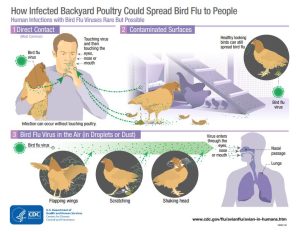Avian flu virus H5N1: No proof for existence, pathogenicity, or pandemic potential

Europe Reloaded / Pam Barker
First off, Dr. Paul Alexander reminds us that the WHO is warning of us of yet another viral pandemic, while questioning the use of a vaccine against it. Below that is a scientific paper by David Crowe and Torsten Engelbrecht going the rounds, which long ago disproved the ability of H5N1 to jump to humans (if it even exists), showing that previous fear-porn claims about H5N1 pandemic potential (yes, they’ve done this before) were unfounded.
More panic to get another shot in our arms? Notice how this story dovetails with the destruction of egg facilities and chickens. This from the CDC:


Avian flu virus H5N1: No proof for existence, pathogenicity, or pandemic potential; non-“H5N1” causation omitted
David Crowe and Torsten Engelbrecht
WHO, CDC, Robert Koch Institute (RKI), and Friedrich Loeffler Institute (FLI) claim that H5N1 (avian flu virus) is “highly contagious”. Further, Reinhard Kurth, president of RKI, says that H5N1 “threatens potentially all six billion people on earth”.
We identified four fundamental questions underlying these claims and requested supporting studies from FLI (which according to the German Government “possesses virus isolates of H5N1”):
- 1 Does H5N1 exist?
- 2. Is it pathogenic to animals?
- 3. Is it transmissible and pathogenic to humans, and does it have pandemic potential?
- 4. Have other causes for observed disease been studied?
Question 1 (existence. … Though the EID study failed to detect “H5N1” in several of the diseased [human] organs, this anomaly was labelled an “enigma”, rather than a “contradiction”.
Question 2 (animal pathogenicity). Papers describe the use of natural routes, but disease was only achieved with extraordinary concentrations, up to 10 million EID per animal. None of the experiments used controls or blinding. The Science paper is highly abstract molecular science, employing elevated concentrations of chimeric variants.
Question 3 (human pathogenicity and pandemic potential). The EID paper is an anecdotal report of a 6-year-old boy from Thailand with severe multi-organ disease. No evidence was given for transmissibility to humans. The scientists found evidence of aspergillosis, and the boy was treated with toxic agents (broad-spectrum antimicrobial and antivirals) before he died.
Subbarao et al. (referenced by the EID paper), describes a previously healthy 3-year-old Hong Kong boy who developed flu-like symptoms in May 9, 1997, and was treated with broad-spectrum antibiotics and salicylic acid, though this is commonly contraindicated. He developed Reye’s Syndrome and died eleven days later [7]. A search commenced for causation within a limited range of flu viruses. H5N1 was claimed causative, even though coronaviruses, flaviviruses, enteroviruses, other pathogens and chemicals can also cause flu symptoms. There was no confirmation of prior avian contact. Regardless, warnings of an “explosive pandemic” appeared in this early document, though FLI conceded: “There is no scientific forecasting method that can evaluate the possibility that an influenza virus induces a new pandemic.”
Our analysis shows the papers do not satisfy our four basic questions. Claims of H5N1 pathogenicity and pandemic potential need to be challenged further.
Original Article: https://www.europereloaded.com/avian-flu-virus-h5n1-no-proof-for-existence-pathogenicity-or-pandemic-potential/

Comments ()